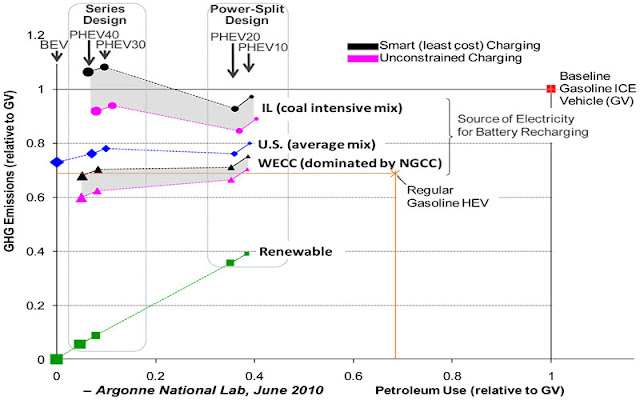
Plug-in electric vehicles, now beginning to be available (such as the battery-electric Nissan Leaf, above, and plug-in hybrid Chevy Volt), are the most feasible alternative to oil-powered cars.

Vehicle fuel efficiency helps, but cannot get us off oil. EPA-NHTSA rulemaking – in conjunction with California ARB – is beginning for 2017-2025. A range of 3-6% annual improvement would result in 47-62 mpg in 2025, compared with 34.1 mpg in 2016 and 27.5 mpg of the old (1990-2010) CAFE.
In comparison, a 2004-9 Toyota Prius midsize car was rated at 46 mpg. A fleet averaging that would cut U.S. gasoline use in half and U.S. oil use by 1/4.
Cartoon (c) by Steve Nease, used with permission

Most U.S. personal trips are by car (U.S. Census, SF-3, QT-P23), although less so in dense cities with good public transit like San Francisco, where only 41% drove alone, 31% rode transit, and 9% walked – a strong reason to oppose new sprawl development.

Fifty percent of drivers travel less than 25 miles per day (EPRI PDF). There is ample off-peak grid capacity today for overnight charging, and vehicle batteries can become distributed storage for demand peaks and renewable supply.

From renewable solar, wind, and geothermal power, the core of our clean energy, green jobs economic future.

But even on U.S. average-mix electricity Argonne National Lab's June 2010 "Well-to-Wheels Analysis ..." documented that plug-ins have lower GHG emissions than equivalent ICE gasoline cars, about the same on a coal-intensive mix, and of course much better with renewables (Figure ES-1, page 3).
See also Michael Brune's Sierra Club blogs 10/6/10 and 3/10/11; California ARB on zero Emission Vehicles, advocate Plug In America, Top 11 Electric Car Myths, and lithium availability.

We will need to plan for charging stations in apartment garages, public street parkways, and retail and commercial locations.

Biofuels, conversely, fail the key criteria of scalability, net energy, and external impacts.
Ethanol from corn uses about as much fossil-fuel energy to grow and make as it yields. It consumes water and fertilizer and competes with food production. Ethanol from sugar cane in Brazil is more sustainable, but not scalable to replace any large portion of oil.
Cellulosic ethanol is not in large-scale production, and has poor net energy due to transporting biomass and distilling the alcohol.
Biodiesel from used french fry oil sounds great, but there's not very much used french fry oil! The most productive oil crops are palm oil and soybeans. Their expanded production threatens rainforest land, hardly a benefit to global warming emissions.
See also Robert Rapier on The Palm Oil Conundrum and Five Challenges of Next-Generation Biofuels.

Hydrogen is an energy carrier, not source. It is mostly created from natural gas today, just another fossil fuel.
Even if electrolyzed from renewable electricity, it is less efficient to make, compress, and run a fuel cell on hydrogen than to just charge a battery (page 5, Table 2 in Boschert).
We need a solution now, but fuel cell vehicles are extremely expensive, plus there is no hydrogen fueling infrastructure.
BACK: 3. Alternatives to Driving
No comments:
Post a Comment